Andhra University 2007 B.E MATHEMATICS - IIICommon to Civil, Mechanical, EEE & ECE Branches) - Question Paper
II Year B.E/B.Tech
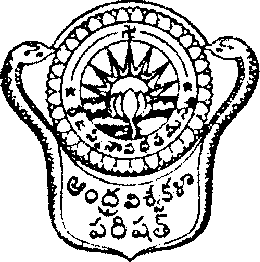
(Effective from 2005 admitted batch)
SCHOOL OF DISTANCE EDUCATION ANDHRA UNIVERSITY VISAKHAPATNAM - 530 003
MATHEMATICS - III
(Common to Civil, Mechanical, EEE & ECE Branches)
Maximum : 75 Marks
Time : Three hours
Question 1 is compulsory Answer any four from Questions 2 to 8 All questions carry equal marks
1. a) Define scalar and vector point functions.
b) Write down the physical interpretation of curl.
c) Explain briefly the wave equation with reference to transverse vibration of a string.
d) Define Fourier transforms of the derivatives of a function.
e) State Parsevals identity for F - transforms.
2. a) What is the directional derivative of 0 = + yz5 at the
point (2, -1, 1) in the direction of the normal to the surface x log z - y2 = - 4 at (-1, 2, 1)?
b) Verify Stokes theorem for the vector field f = (2x-y) i-
yz2 j -y2z k over the upper half surface of x2 + y2+z2=1 bounded by its projection on the xy plane.
3. a) If r and R have their usual meaning and A is a constant

vector prove that Vx
b) Prove that the spherical polar coordinate system is orthogo-
nal.
Printed by : SRIRAM PRINTERS, Vsp-27. Copies : 2000, Year : 2007
4. a) If (z) is a regular function of z prove that |f(z )|2 _ 4 f (2)|2
b) Braluate (x2 +!) ( + 4)
i_ -d_
dx2 +d/
5. a) Find the Fourier transform ofg-/2
Jl, O < x < a 1
b) Find the Fourier sine transform of f(x) = x>
d 2u _du
6. a) Find a solution of the equation = ~dy + in the form
u = f (x) g (y). Solve the equation subject to the conditions
du 3
u = 0 and _1 + e y when x = 0 for all values of y. dx
b) A tightly stretched flexible string has its ends fixed at x = 0 and x = l. At time t = 0 the string is given a shape given by f (x) = m x (l _ x) where mis a constant and then released. Find the displacement of any point x of the string at any time t > 0.
7. a) A continuous distribution of a variable x in the range ( -3, 3)
is defined as
f(x)_ (3 + x)2, _3<x<_ 1.
16 '
=(2-6x)2 , -1 <x<1.
16
= (3 - x)2, 1< x< 3.
16
Verify that the area under the curve is unity. Show that the mean is zero.
b) Fit a Poisson distribution to the following.
x : 0 12 3 4
f : 46 38 22 9 1
8. a) Find the correlation coefficient from the following data :
x : 1 2 3 4 5 y : 2 5 3 8 7
b) The following results were obtained in Applied Mechanics and Engineering Mathematics in an examination. Given r=0.95, Find both the regression equations.
Applied Mech. Engg. Maths
(x) (y)
Mean 47.5 10.5
Standard deviation 16.8 10.8
MICRO-PROCESSORS APPLICATIONS
(Mechanical, Engineering)
Time : Three hours Maximum : 75 Marks
Question 1 is compulsory Answer any four from Questions 2 to 8 All questions carry equal marks
1. a) Differentiate text mode and graphics mode. Explain the
various line styles with proper syntax ofC.
b) What do you mean by transformations in C graphics. Give a generalized 3D transformation matrix for scaling.
c) What are the octal and hexadecimal equivalents of (282)10?
d) What are logical gates? Draw a logical circuit of A + A B.
e) Mention some basic differences between micro, mini and mainframe computers.
2. a) What are basic graphic primitives? Explain them with C
functions.
b) Write C code for drawing n sided regular polygon with each side length as / and a central hole of diameter d. Also fill the polygon excluding hole with horizontal lines having red color.
3. a) Explain Chohen-Sutherland algorithm for line clipping.
b) Write C program for drawing a parabola having focal length a.
4. a) Perform 300 clockwise rotation of a triangle A (10,10),
B(70,20), C(30,50), (i) about origin and (ii) about P(3,-2).
b) Explain the transformation of world coordinates into user defined view port coordinates.
5. a) Explain one algorithm of animation.
b) i) Find the demical equivalent of (101 101.0101)2. ii) Find the binary equivalent of (284.538)10.
6. a) i) Given the truth table and logical circuit for y = XY + XY
ii) State and prove De Morgans theorems. b) Explain the flip-flops (i) S-R flip-flop and (ii) J-K flip-flop.
7. a) Draw the internal architecture of 8085.
b) Name different addressing modes. Explain direct addressing mode and immediate addressing mode.
8. a) What is an interrupt? Explain Enabling, Disabling and
Masking of interrupts.
b) Develop a flow chart to find the transpose of a matrix.
ENGINEERING ECONOMICS
(Mechanical, Engineering)
Time : Three hours Maximum : 75 Marks
Question 1 is compulsory Answer any four from Questions 2 to 8 All questions carry equal marks
1. a) What is Demand and Supply.
b) What is a business organization ?
c) What is perfect competition ?
d) What is unit costing ?
e) What is depreciation ?
2. a) Explain the terms utility value wealth and consumption.. b) What is meant by elasticity of demand ? Discuss.
3. a) What are the features of partnership company? Explain.
b) Discuss the laws of returns and agents of production in detail.
4. a) Comparatively discuss the perfect competition and imper
fect competition.
b) Explain the merits and demerits of payment by cash and by cheques.
5. a) What are the direct costs and indirect costs? Discuss with
examples.
b) What is meant by process costing? Discuss with examples.
6. a) Explain the merits and demerits of public limited company
along with its formation?
b) What is money? Explain the functions of money.
|
7. From the following balance of ABC & Co. prepare final | ||||||||||||||||||||||||||||||||||||||||||||||||||||||||||||||||||
| ||||||||||||||||||||||||||||||||||||||||||||||||||||||||||||||||||
a) Closing stock as on 31-3-99 Rs. 36,420/-
b) Interest on capital @ 5%
c) Outstanding salaries Rs. 6,000/-
d) Depreciate machinery @ 10%
e) Credit reserve for bad debts @ 5% on sundary debtors.
8. a) What is break even analysis? Explain.
b) Calculate depreciation for a machine using (i) straight line method. (ii) declining balance method with interest of
Rs. 10%.
Initial cost of the machine Terminal value Life period
Rs. 1.20.000/Rs. 5.000/10 years.
II Year B.E./B.Tech Degree Examination FLUID MECHANICS AND FLUID MACHINES
(Mechanical, Engineering)
Maximum : 75 Marks
Time : Three hours
Question 1 is compulsory Answer any four from Questions 2 to 8 All questions carry equal marks
1. a) Enumerate Newtons law of Viscosity. Explain the
importance of viscosity in fluid motion.
b) State and explian Buckinghams p - theorem.
c) State the Bernoullis theorem for compressible flow.
d) Differentiate between an inward and an outward flow reaction turbine.
e) What is cavitation? Explain in brief how to prevent cavitation in water turbines.
2. a) Define stream function. What are the conditions for flow to
be irrotational?
b) A 30 cm diameter pipe carries water under a head of 15 meters with a velocity of 4 m/s. If the axis of the pipe turns through 450 find the magnitude and direction of the resultant force at the bend.
3. For the velocity profile for laminar boundary layer
/ \3 / \4 y y
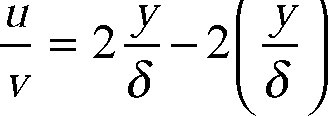
+ Obtain an expression for
boundary layer thickness. shear stress. drag force on one side of the plate and coefficient of drag in terms ofReynolds number.
4. a) Derive an expression for Hagen Poiseuilles formula giving
its applications.
b) A pipe line 60 cm in diameter bifurcates at a Y-junction into branches 40cm and 30cm in diameter. If the rate of flow in the main pipe is 1.5 m3/sec. and mean velocity of flow in 30 cm diameter pipe is 7.5 m/sec. determine the rate of flow in the 40 cm diameter pipe.
5. a) Derive an expression for Bernoullis equation when the
process is isothermal.
b) A gas with a velocity of300 m/s is flowing through a horizontal pipe at a section where pressure is 6x 104 N/ m2 (absolute). Find the velocity of the gas at this section if the flow is adiabatic. Take R = 287 J/kg and K = 1.4.
6. a) Prove that the force exerted by a jet of water on a fixed
semi-circular plate in the direction of the jet when the strikes at the centre of the semi-circular plate is two times the force exerted by the jet on a fixed vertical plate.
b) The water in a propelled boat is drawn through inlet openings facing the direction of motion of the slip. The boat is moving in sea water with a speed of 40 km/hr. The absolute velocity of the jet of the water discharged at the back is 40m/s and the area of the jet of water is 0.04m2. Find the propelling force and the effcicency of propulsion.
7. a) i) What is meant by the speed ratio of a Pelton wheel ?
ii) Differentiate between Impulse and reaction turbines.
b) A turbine develops 7257.5 S.P. when running at 200rpm. The head on the turbine is 40m. The head on the trubine is reduced to 25m, determine the speed and power developed by the turbine.
8. a) What is a reciprocating pump ? Describe the principle and working of a reciprocating pump with a neat sketch.
b) A single-acting reciprocating pump. running at 50 rpm is discharging 900 litres of water per minute. The pump has a stroke of400 mm. The diameter of the piston is 250 mm. The delivery and suction heads are 25 m and 4 m respectively. Find the slip of the pump and power required to derive the pump.
THEORY OF MACHINES - I
Mechanical Engineering
Time : Three hours Maximum : 75 Marks
1. a) State the conditions under which two shafts connected
together by a double Hookes joint shall have the same angular velocities. (3)
b) Define coriolis component of acceleration. Indicate its magnitude and direction. (3)
c) What conditions must be satisfied by two mass system to be dynamically equivalent to the rigid body? (3)
d) Explain the terms Friction circle and Friction axis. (3)
e) What are the relative advantages and disadvantages of (i) flat belts and (ii) chains for the transmission of power. (3)
2. a) What do you mean by constrained motion? Explain different
types of constrained motions with examples and neat sketches. (7)
b) Explain inversions of a four bar chain with neat sketches.
(8)
3. In the mechanism shown in Fig. 1, OA is fixed, CD = 200 mm, OA = 60 mm, AC = 50 mm and OB (crank) = 150 mm, /_ OAD = 900. Determine the velocity and acceleration of D for counter clock wise rotation of OB at 80 rpm.
(15)
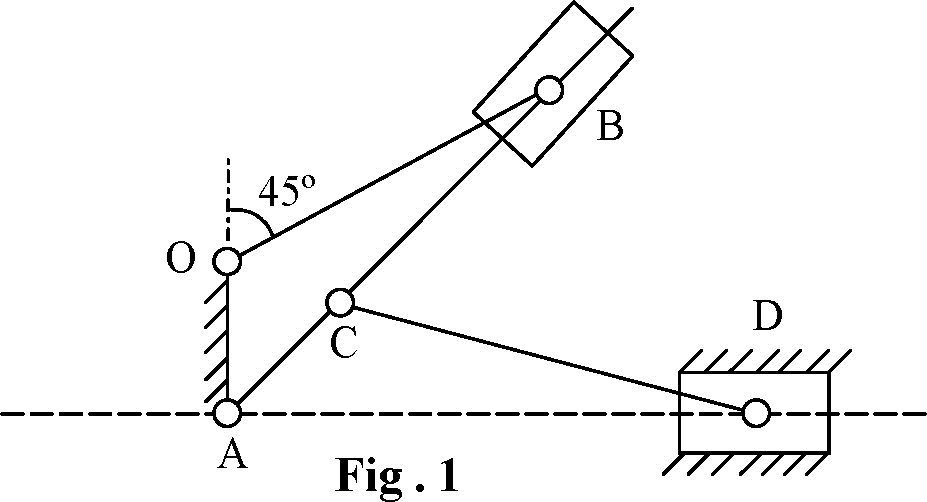
4. a) Hooks joint connects two shafts intersecting at 1500. The
driving shaft rotates at 120 rpm. The driven shaft operates against a steady torque of 150 Nm and carries a flywheel of mass 45 Kg and radius of gyration 15 cm. What is the maximum torque which must be exerted by driving shaft?
(7)
b) What are different types ofsteering gear mechanisms ? Show that Davis steering gear mechanism provides correct steering. (8)
6. a) A certain machine tool does work intermittently. The machine
is fitted with a flywheel ofmass 200 Kg and radius ofgyration of 0.4 m. It runs at a speed of 400 rpm between the operations. The machine is driven continuously by a motor and each operation takes 8 seconds. When the machine is doing its work, the speed drops from 400 to 250 rpm. Find (i) Minimum power of the motor, where there are 5 operations performed per minute and (ii) Energy expanded in performing each operation. (15)
7. a) Deduce and expression for the friction moment of a conical
thrust bearing and state what assumptions are made. (7)
b) Calculate the power absorbed in overcoming friction and number ofcollars required for the thrust bearing whose collars have 20cm external radius and 15cm internal raidus. Coefficient of friction is 0.03. Total axial load is 30 KN. Intensity of pressure is 0.35 N/mm1, speed of shaft is 420 rpm. (8)
PRODUCTION DRAWING
Mechanical Engineering
Time : Three hours Maximum : 75 Marks
Answer all questions.
(Tolerance tables are not permitted)
Figures on right hand margin indicate the marks.
ii)
0.01
0.02
iv)
0.01 (M
0.3
A B
i) S iii)
Sketch the following with appropriate tolerance frames.
b)
(6)
Axis of a hole is located within a cylinder of 0.3 mm at a distance of 30 mm and 40 mm from the datum surfaces A and B respectively.
i)
The rollers of a sine bar are parallel within tolerance of
ii)
0.002 mm and the cylindricity of each roller is within
0.005 mm.
iii) The flat face ofa component should be contained between two parallel planes 0.05 mm apart.
3. a) How the following are represented ? (5)
i) Double-V butt weld
ii) Wood
iii) Holes on circular pitch
iv) External and internal threads on a component
v) Roller bearing
b) Draw various types of set screws of15 mm size. (4)
4. Draw (a) M 18 x 70 square bolt with nut, (b) Hole 010, CSK 015, Deep 5 mm, (c) Taper key of size 12 x 8 x 50 mm, (d) Indicate roughness grade numbers and symbols for the roughens values Ra=25.0 mn and Ra=0.8 mn. (6)
5. Prepare the working drawings (with necessary tolerances and roughness symbols) for the individual components, i.e.
(i) Valve seat, (ii) Gland of a feed check valve assembly shown in Fig.1. (10)
6. Draw the detailed drawing of the pattern and mould for costing cover (part 3) in the assembly shown in Fig.1.
(10)
7. Prepare the process sheet for the manufacture of spindle of the above assembly shown in Fig.1, from a rod of 35 mm diameter. (10)
8. A typical sheet metal fabrication requires the following shapes and number form a G.I. sheet of 1.5 mm thick. Draw the strip layout and estimate the required width and length of the sheet for the minimum scrap. (10)
1) Right angled triangular parts of sides 20 x 30 - 5 Nos.
2) Rectangular parts of 40 mm x 30 mm - 6 Nos.
3) Circular parts of radius 20 mm - 4 Nos.
|
mo 12., , \S |
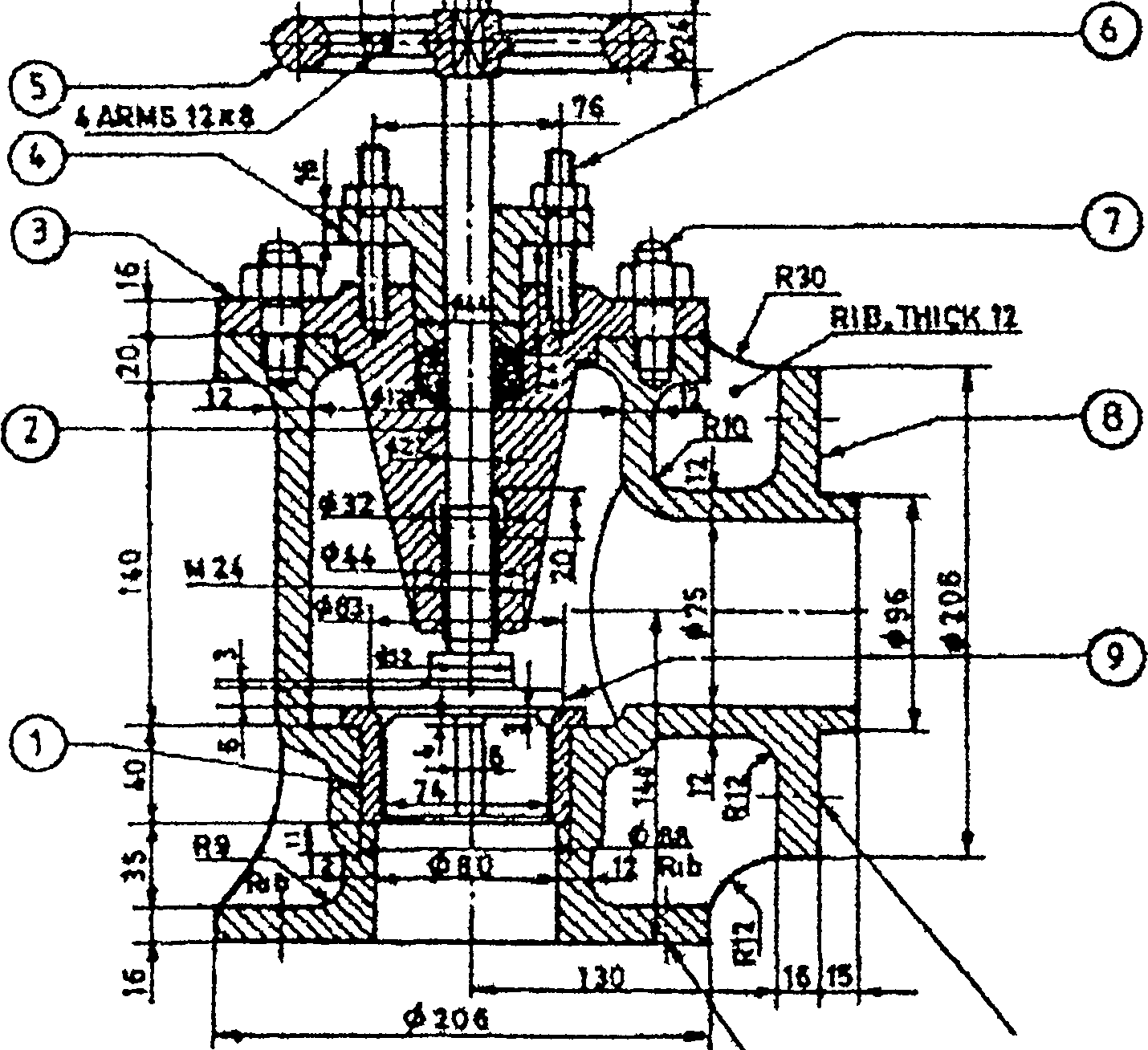 |
|
6 HOLE Su 01 A* \ PCD 52 |
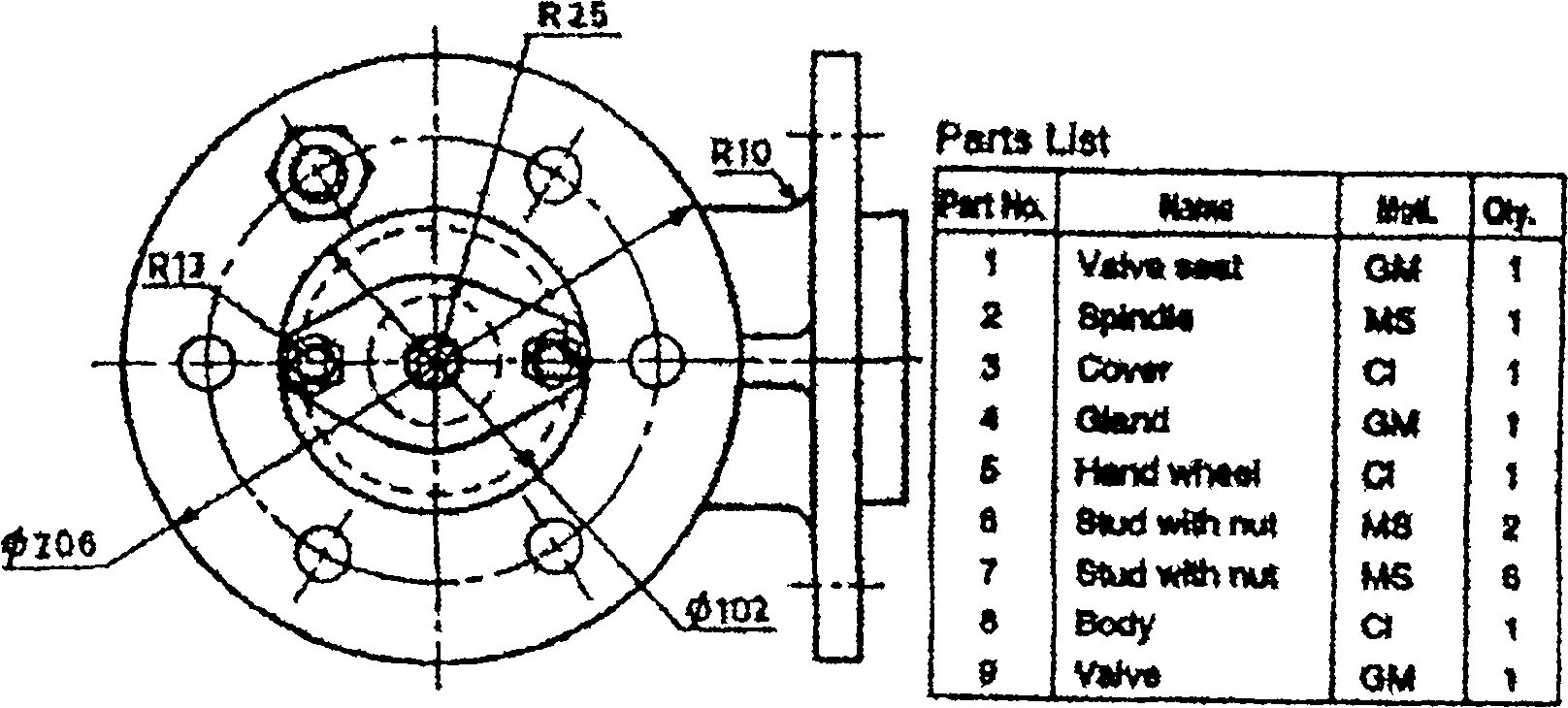 |
|
Fig : 1 Feed check valve |
PRODUCTION TECHNOLOGY
Mechanical Engineering
Time : Three hours Maximum : 75 Marks
Question 1 is compulsory Answer any four from Questions 2 to 8 All questions carry equal marks
1. a) How DNC is different from CNC ? (3)
b) Designate axes for 4-axis milling machine (3)
c) What are thread gauges? How do you check threads using them ? (3)
d) How machine vision system is used in Metrology (3)
e) Describe Arithmetic Average and RMS Average of surface roughness. (3)
2. a) What is a machining center? Describe its important features.
(7)
b) Explain Tool length compensation and Tool radius compensation in NC part programming. (8)
3. a) What are the common Robot configuration? Explain them
briefly. (7)
b) What is FMS? Discuss its advantages. (8)
4. Write manual part program for turning the component shown in Fig.1 (for only finish cutting). (15)
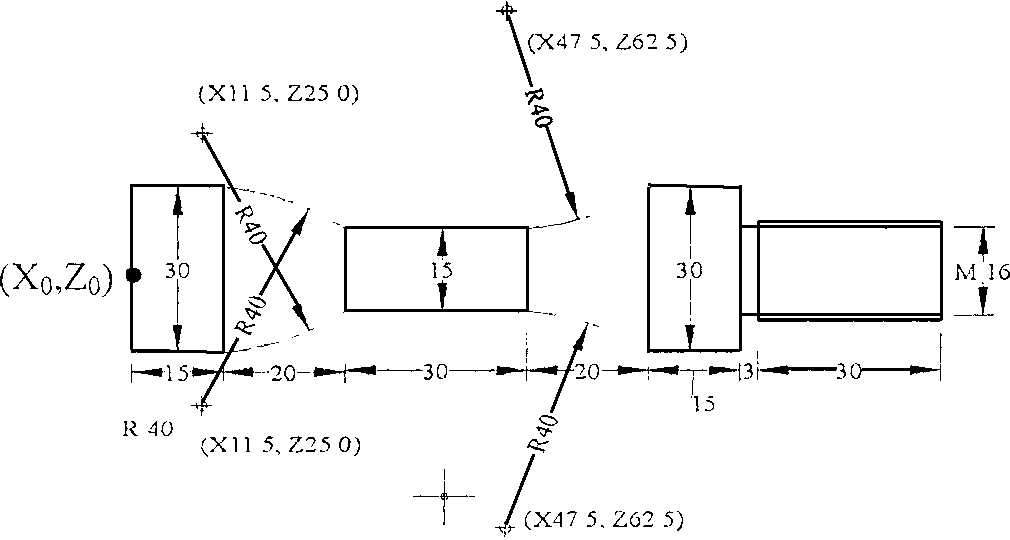
Fig . 1
5. a) What is Taylors principle as applied to design of limit
gauges? Explain how do you apply for design of GO & NO GO plug gauge. (8)
b) Give screw thread terminology on a sketch and explain any method for finding the pitch of the thread. (7)
6. a) Explain any one gear tooth profile measuring technique.(8) b) What is squarness measurement and explain. (7)
7. a) What is the working principle of pneumatic comparator?
Briefly enumerate the advantages of differential pneumatic comparator. (8)
b) Explain how sine bar is used in measurement of tapper angle.
(7)
8. a) Describe any one method of measuring surface roughness.
(7)
b) Describe with sketches, how would you check (i) parallelism of main spindle of lathe to its saddle movement, (ii) true running of internal taper ofmain spindle ofmilling machine.
(8)
20
a) Explain the geometrical tolerances features indicated by the
following frames : (4)
|
Attachment: |
| Earning: Approval pending. |
